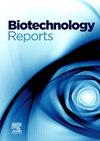Montbretia flowers as a source of bioactive crocins: Biotechnology tools and delivery systems
Q1 Immunology and Microbiology
引用次数: 0
Abstract
Crocins are potent antioxidants with significant therapeutic potential, exhibiting anti-inflammatory, anticancer, and antidepressant properties. The ornamental plant Crocos-mia x crocosmiiflora is widely cultivated for its aromatic and vibrant flowers. In this study, we identified unique crocins as the primary pigments responsible for the flower's coloration. These metabolites predominantly consist of molecules with eight glucose units, followed by crocins containing six and seven glucose units. To elucidate the mo-lecular mechanisms underlying crocin biosynthesis in C. x crocosmiiflora, tran-scriptomic analysis was performed to identify key carotenoid cleavage dioxygenase (CCD) genes. Using Crocus sativus CsCCD2L gene as a bait, we identified a CCD transcript from the transcriptome data. Phylogenetic analysis revealed that the identified CCD belongs to the CCD2 subfamily, and it was designated as CroCCD2. Functional characterization of CroCCD2 was carried out using bacterial expression systems and Nicotiana benthamiana plants with a virus-mediated expression system. These experiments demonstrated that CroCCD2 efficiently converts the precursor zeaxanthin into crocetin, a key intermediate in crocin biosynthesis. Furthermore, we investigated the bioactivity of crocins and discovered that their anti-inflammatory effects depend on their vehiculation within exosomes or liposomes. This suggests that the transport mechanism is critical for the biological activity of crocins. Our findings highlight the specialization of CCD subfamilies in monocots and dicots for crocin biosynthesis and provide evidence of the anti-inflammatory activity of exosome-transported crocins. This study establishes a foundation for further research into the metabolic network of crocins in C. x crocosmiiflora and suggests that the CroCCD2 gene could be introduced into other crop plants to produce these bioactive apocarotenoids.

作为生物活性藏红花的来源:生物技术工具和输送系统
藏红花素是有效的抗氧化剂,具有显著的治疗潜力,表现出抗炎、抗癌和抗抑郁的特性。观赏植物crocosmiiflora因其芳香和鲜艳的花朵而被广泛种植。在这项研究中,我们确定了独特的藏红花色素作为主要色素负责花的颜色。这些代谢物主要由含有8个葡萄糖单位的分子组成,其次是含有6个和7个葡萄糖单位的藏红花。为了阐明藏红花素生物合成的分子机制,通过转录组学分析鉴定了类胡萝卜素裂解双加氧酶(CCD)的关键基因。以藏红花CsCCD2L基因为诱饵,从转录组数据中鉴定出一个CCD转录本。系统发育分析表明,该CCD属CCD2亚家族,命名为CroCCD2。用细菌表达系统和用病毒介导的烟植物表达系统对CroCCD2进行功能表征。这些实验证明CroCCD2有效地将前体玉米黄质转化为藏红花素,这是藏红花素生物合成的关键中间体。此外,我们研究了藏红花素的生物活性,发现它们的抗炎作用依赖于它们在外泌体或脂质体中的运载作用。这表明运输机制对藏红花素的生物活性至关重要。我们的研究结果强调了CCD亚家族在单子体和双子体中对藏红花素生物合成的专门化,并为外泌体运输藏红花素的抗炎活性提供了证据。本研究为进一步研究藏红花属植物中藏红花素的代谢网络奠定了基础,并提示可以将CroCCD2基因引入其他作物植物中以产生这些具有生物活性的类藏红花素。
本文章由计算机程序翻译,如有差异,请以英文原文为准。
求助全文
约1分钟内获得全文
求助全文
来源期刊

Biotechnology Reports
Immunology and Microbiology-Applied Microbiology and Biotechnology
CiteScore
15.80
自引率
0.00%
发文量
79
审稿时长
55 days
期刊介绍:
Biotechnology Reports covers all aspects of Biotechnology particularly those reports that are useful and informative and that will be of value to other researchers in related fields. Biotechnology Reports loves ground breaking science, but will also accept good science that can be of use to the biotechnology community. The journal maintains a high quality peer review where submissions are considered on the basis of scientific validity and technical quality. Acceptable paper types are research articles (short or full communications), methods, mini-reviews, and commentaries in the following areas: Healthcare and pharmaceutical biotechnology Agricultural and food biotechnology Environmental biotechnology Molecular biology, cell and tissue engineering and synthetic biology Industrial biotechnology, biofuels and bioenergy Nanobiotechnology Bioinformatics & systems biology New processes and products in biotechnology, bioprocess engineering.
 求助内容:
求助内容: 应助结果提醒方式:
应助结果提醒方式:


